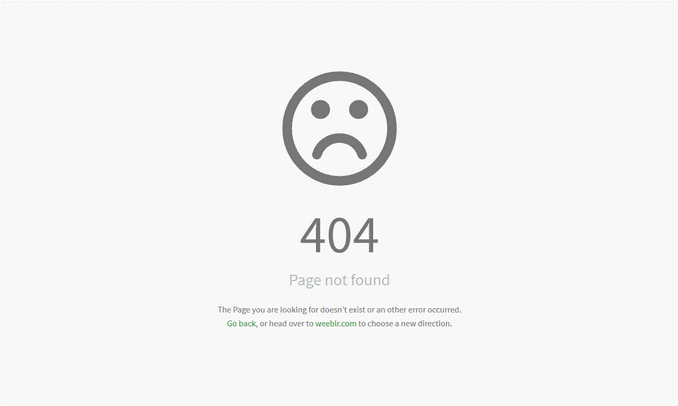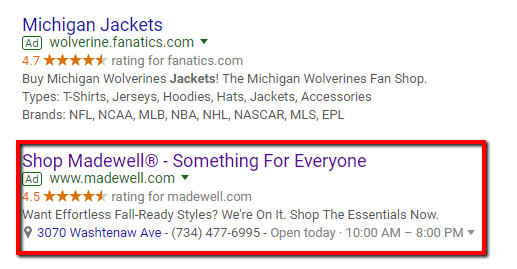As Halloween draws near, people are engaging in a variety of activities to satisfy their thrill to be scared. While being frightened by a haunted house or scary movie is a sought-after experience, being scared away from clicking to a website by an ad is an unwanted experience for both customers and advertisers. In this article, we will look at thirteen weird, freaky, and downright wrong AdWords ads that are sure to terrify any PPC (pay-per-click) advertiser.
#1 – Ads with Misspelled Words in Your Ad Text

Misspelled words within your ad text may not seem like a huge deal, but in some cases, it may cause users to overlook your business. Multiple misspelled words within your ad text can look unprofessional as well as sloppy and deter potential users from clicking on your ad.
While spelling and grammar can be easily overlooked, it can also be easily correct by either re-reading your ad text or using spellcheck.
#2 – Ads Failing to Use Available Ad Space

With Expanded text ads, AdWords provides you with two 30-character headlines and one 80-character description space to write your ad text. This space can be used to include a wide range of information about your business or products, including price, product benefits, highlights about your business, or any other information that separates your business from your competitors.
By adding more information about your business within your ad text, you can provide the end user with a better understanding about your business prior to clicking the ad. The example ad misses out on the opportunity to highlight the types of supplies offered on the page or if they have pet supplies for just cats and dogs or other types of pets as well.
When writing your ads, always try and use as much space as possible. This will allow your ad to use more ad real estate on the page and better inform potential customers.
#3 – Ads with Excessive or No Capitalization
When writing your ads, pay attention to the amount of capitalization that you use. Using too much or too little capitalization can have negative impact on your AdWords performance.

Capitalizing entire words or sentences within your ad text tends to come off as over aggressive and may cause users to click on other ads. All capitalized words tend to make users feel that ads are shouting at them and deter ad clicks.
Another reason to avoid capitalizing entire words is due to AdWords policies. AdWords does not allow for entire words to be capitalized and will disapprove ads that fail to adhere to this policy.

Writing your text ad with no capitalization can also result in lower performance. Ads with no capitalization not only do not follow general grammar rules, but are often overlooked and appear passive. These ads tend to be skipped and do not stand out from your competition.
In order to eliminate capitalization issues, it is best practice to use title case capitalization, which refers to capitalizing the first letter of each word within your ad text.
#4 – Ads with Excessive Punctuation

Excessive punctuation within ad text is another ad mistake that can cause issues with your AdWords account. AdWords does not allow for repeated or gimmicky punctuations that does not adhere to their true meaning or purpose. If an ad has excessive punctuation, AdWords will disapprove the ad and not allow it to run.
Certain punctuations are not allowed within ad text where as others are allow on a limited basis. For example, AdWords will only allow one exclamation point to be used within an ad and it cannot be in the headline.
#5 – Ads Not Using Ad Extensions

When creating your ads, always take advantage of related ad extensions. Ad extensions not only provide more information about your business within the ad text, but also make your ad bigger and take up more ad space.
The example ad is trying to get clients to call their business, but the advertiser has not implemented call extensions for their ads. With call extensions enable, this advertiser would be able to show their phone number with their ad and get a click to call option for mobile searchers.
Ad extensions are easy to create and can be used for a wide variety of goals. You can use location extensions if you are a brick and mortar location looking for in store traffic, or sitelink extensions if you are trying to lead users to specific goal pages on your website. There are really no disadvantages to using ad extensions and implementation can help to drive results.
#6 – Ads with No Call to Action

While the ad above has a lot of information about the business and includes a few different ad extensions, the ad does not include a call to action to tell the user what they should do after they click to the website. You do not want to assume that a potential client knows what action they should take on your website after they click.
Another example would be for a business that sells products, but does not have an Ecommerce website. If a user goes to the website thinking they can buy from the website and does not see a purchase process, they have a higher chance of leaving the page and finding a different website to buy from. If the ad text they initially click on states to call or fill out a form to inquire about purchasing, this user now has a better understanding of the company’s ordering process.
Adding a call to action within your ad text tells the user what action to take once they are on your website. This helps to provide direction for the user once on the page and lets them know the best way to contact you or buy your product.
#7 – Ads that State What the Business Doesn’t Do

When writing your ad text, always highlight the benefits of your business. The example ad not only tells us what they don’t offer which can discourage ad clicks, but they provide no other benefit for using their services. If this business doesn’t provide services to proms or school dances, do they still provide services for other events?
Your ad is the first opportunity to showcase your business in a positive light before a user clicks and goes to your website. Try to include information that separates you from competitors including services or products offered, years in service, excellent customer service, or any other aspect of your business that can entice a potential client to choose your business over all the others.
#8 – Ads that are Outdated

Here is another example of an ad that is providing beneficial business information and using best practice techniques, but has one major issue. This ad is all about Labor Day Sales, but I found this ad on the search results page more than a month after Labor Day in mid-October.
If you are running ads that are time sensitive or have a specific end date, make sure to adjust them accordingly once the timeframe has passed. Running ads that are outdated can either cause users to seek other businesses for their needs or cause you to waste money on clicks that lead to no additional benefit for your business.
To make sure that you are not running outdated ads, make sure you continually update your ads. Changing your ad text regularly allows you to test new messaging and provide users with the latest promotions or offers.
#9 – Ads Directed to Broken Links

When an ad click leads to an error page, it can have costly consequences for an advertiser. These clicks not only cost you money that you have no chance of getting a return on, but also provides the end users with a bad user experience. These users will be driven to a competitor and may also be discouraged from clicking to your website in future searches.
Continuously monitor your ads to make sure that they are not leading to broken links so you do not waste advertising spend on useless clicks. If an ad is leading to a broken link, either change the final URL of the ad or work with your webmaster to get your webpage back up and running as quickly as possible.
#10 – Ads Directed to an Unrelated Page
While leading ads to an error is one example of a landing page ad mistake, leading users to a landing page that is unrelated to your ad text can be just as costly. For example, let’s say that you own a clothing store with an Ecommerce website. If you create ads focused on women’s jeans, it would not be beneficial to send users to your home page or your general women’s clothing page. Users sent to either of these pages would have to dig through multiple pages of your website before finding their desired information.
The longer it takes for a user to find the information they are looking for, the more likely they are to leave your page and go to another website. When choosing the landing page for your ad, it is best practice to send users to the most specific page related to your ad text. This ensures that users find the information they are looking for and do not have to search multiple pages on your site first.
#11 – Ads with No Keywords in the Text

Along the same lines as directing users to the correct landing page after they click on the ad, you also want to make sure that the keyword the user searches for appears in the ad text. Ads that fail to incorporate keywords into the ad text have a higher chance of being overlooked by users on the search page.
While searching for “jackets” I received the two ads in the example above. The highlighted ad has no mention of word “jackets” and leaves the searcher guessing as to whether or not they actually sell jackets on their website.
Adding keywords to your ad text has many benefits for you as an advertiser. One advantage is that Google with automatically highlight the users keyword that trigger the ad in bold text. This makes the users search term stand out in your ad text and helps to show that your ad is relevant to their search. Having keywords in your ad text can also positively affect your AdWords account. One of the factors to keyword quality score is ad text relevance, so adding keyword to your ad increases your quality score which can in turn lower your average CPC (cost-per-click).
#12 – Ads that Do Not Show Pricing
While not necessary for all business, in certain situations not showing pricing information can be a costly ad mistake. For some competitive industries, price can be a major selling point for a business.
Examples of when not having pricing information within your ad text could hinder your ads performance are when your business is the lowest cost product or service or if you want to avoid the customer getting “sticker shock” once they click on your ad and go to your page. If your business offers a similar product or service at a lower price, it is best practice to highlight this in your ad text. Since price is your major selling point, it can attract users to your ad text and encourage them to click to your website.
On the other hand, if your business tends to have higher prices than competition it can also be beneficial to add price to your ad text. This can work as a deterrent for users that are just searching for the lowest price and keep you from spending money on clicks that will not generate business.
Including pricing information within your ad text may not be useful for all business, but others may find this strategy to be more cost effective in the long run.
#13 – Ads Showing the Wrong Location

Using locations within your ad text can help inform users where your business works or provides services. The downside comes into effect when you have the wrong location showing for a user.
In the example ad, we see a business that provides snow removal services for Ohio. Since I am located in Michigan, this ad is not relevant for me. Me as a user, or other Michigan users like me, will overlook this ad since the wording is not targeted to us.
When using location specific at text, also make sure that you have set up your campaign location targeting to match. Users are less likely to click on an ad that has geographic text unrelated to them.
Conclusion
When generating ad text for your AdWords account, remember to avoid falling into one of these ad mistake categories. Unlike Halloween, the goal for advertisers is not to scare away potential customers.
Find Out How AdWords Can Transform YOUR Business
If you’re thinking about an e-commerce website or AdWords, please view the Pool & Spa Giant Case Study. You’ll find out exactly what this online store did to “double sales” year-over-year.


